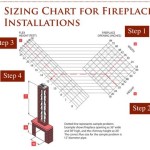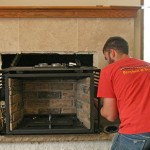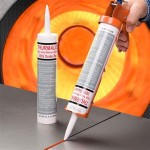The Allure and Practicality of Two-Sided Fireplaces
Two-sided fireplaces, also known as see-through fireplaces or peninsula fireplaces, represent a sophisticated and functional design element that can significantly enhance the aesthetics and value of a property. Unlike traditional fireplaces confined to a single wall, these innovative hearths offer a view of the fire from two separate areas, creating a captivating focal point and a sense of openness within a home or commercial space. This article will delve into the various aspects of two-sided fireplaces, examining their design considerations, installation requirements, fuel options, safety features, and advantages in various contexts.
The concept of a two-sided fireplace is rooted in the desire to maximize the visual impact and heat distribution of a fire feature. They often serve as a natural divider between two rooms, such as a living room and dining room, or a bedroom and bathroom. The transparent nature of the design allows for unobstructed views and creates a seamless connection between the adjacent spaces, fostering a more integrated and inviting atmosphere. The versatility of two-sided fireplaces extends beyond residential applications. They are frequently incorporated into commercial establishments, such as restaurants, hotels, and spas, to create ambiance and enhance the overall guest experience.
Design and Architectural Integration
The design of a two-sided fireplace requires careful consideration of the surrounding architecture, spatial layout, and desired aesthetic. The fireplace must seamlessly integrate into the existing structure while complementing the overall design scheme. Factors such as the size and shape of the fireplace, the materials used for the surround, and the height and width of the opening all play a crucial role in achieving a harmonious and visually appealing result. The architectural style of the building should inform the design choices. For example, a modern home might benefit from a sleek, minimalist two-sided fireplace with clean lines and a contemporary finish. Conversely, a more traditional home might call for a fireplace with ornate detailing, a classic mantel, and a warm, inviting aesthetic.
The placement of the fireplace is equally important. Ideally, it should be positioned in a location where it can be enjoyed from both sides and where it will not obstruct traffic flow or create any safety hazards. In open-concept layouts, a two-sided fireplace can effectively define distinct zones without visually separating them. This is particularly useful in large, multi-functional spaces where it can help to create a sense of intimacy and structure. The height of the fireplace should also be carefully considered in relation to the ceiling height and the scale of the surrounding furniture. A fireplace that is too small may appear insignificant, while a fireplace that is too large may overwhelm the space.
The materials used for the fireplace surround can have a significant impact on its overall appearance. Common materials include brick, stone, concrete, tile, and metal. The choice of material should be based on the desired aesthetic and the existing design elements of the home. Brick and stone are popular choices for traditional fireplaces, while concrete and metal are often used in contemporary designs. The fireplace surround should also be durable and resistant to heat, as it will be exposed to high temperatures during operation. Furthermore, the surround should be easy to clean and maintain. Regular cleaning will help to keep the fireplace looking its best and prevent the build-up of soot and creosote.
Fuel Options and Operational Considerations
Two-sided fireplaces offer a range of fuel options, each with its own set of advantages and disadvantages. The most common fuel types include wood, gas, and electricity. The choice of fuel will depend on factors such as personal preference, budget, environmental concerns, and the availability of fuel sources. Wood-burning fireplaces offer the authentic ambiance and crackling sound that many homeowners find appealing. However, they also require more maintenance than other types of fireplaces, including regular cleaning and the storage of firewood. Wood-burning fireplaces can also contribute to air pollution if not operated properly. Gas fireplaces offer the convenience of instant ignition and adjustable flame height. They are also relatively clean-burning and require less maintenance than wood-burning fireplaces. However, they do require a gas line connection, which may not be available in all homes.
Electric fireplaces are the most convenient and versatile option, as they require no venting or fuel lines. They can be easily installed in any room with an electrical outlet. Electric fireplaces also offer a range of features, such as adjustable flame effects, built-in heaters, and remote control operation. However, they do not produce real flames or the same level of heat as wood or gas fireplaces. The operational considerations for a two-sided fireplace are similar to those for a traditional fireplace. It is important to follow the manufacturer's instructions for proper operation and maintenance. Regular cleaning is essential to prevent the build-up of soot and creosote, which can pose a fire hazard. The chimney or vent should also be inspected regularly for any signs of damage or blockage. It is also important to ensure that the fireplace is properly ventilated to prevent the build-up of carbon monoxide, a deadly gas. Carbon monoxide detectors should be installed in the home to provide an early warning of any dangerous levels.
The energy efficiency of a two-sided fireplace is an important consideration, particularly in colder climates. Fireplaces can lose a significant amount of heat through the chimney or vent, which can increase energy bills. To improve energy efficiency, it is recommended to install a fireplace insert with a sealed combustion system. Fireplace inserts are designed to fit inside an existing fireplace opening and provide a more efficient and controlled burn. They also typically include features such as blowers and thermostats, which can help to distribute heat throughout the room. Another way to improve energy efficiency is to install a damper that seals tightly when the fireplace is not in use. This will prevent heat from escaping through the chimney or vent. Regular maintenance, such as cleaning the chimney and inspecting the firebox, will also help to ensure that the fireplace is operating at peak efficiency.
Safety Features and Code Compliance
Safety is paramount when installing and operating a two-sided fireplace. It is essential to adhere to all applicable building codes and regulations to ensure the safety of the occupants. This includes obtaining the necessary permits and inspections from local authorities. The fireplace should be installed by a qualified professional who is familiar with the relevant codes and safety standards. The fireplace should also be equipped with appropriate safety features, such as a spark screen, a fire extinguisher, and carbon monoxide detectors. A spark screen is a mesh screen that covers the fireplace opening and prevents sparks and embers from escaping. A fire extinguisher should be readily accessible in case of a fire. Carbon monoxide detectors should be installed in the home to provide an early warning of any dangerous levels of carbon monoxide. It is also important to educate all occupants on the proper use and safety precautions associated with the fireplace.
Building codes typically dictate specific requirements for the installation of fireplaces, including clearances from combustible materials, chimney height, and ventilation requirements. These codes are designed to prevent fires and ensure the safe operation of the fireplace. It is important to consult with a qualified professional to determine the specific code requirements for the area. The chimney or vent should be inspected regularly for any signs of damage or blockage. A blocked chimney can cause carbon monoxide to build up in the home, which can be deadly. The fireplace should also be cleaned regularly to prevent the build-up of soot and creosote. Creosote is a highly flammable substance that can accumulate in the chimney and cause a chimney fire. It is recommended to have the chimney professionally cleaned at least once a year, or more frequently if the fireplace is used regularly.
Safe operation also includes proper maintenance. Never leave a fire unattended, and ensure it is completely extinguished before leaving the house or going to bed. Store firewood away from the fireplace and other combustible materials. Keep children and pets away from the fireplace to prevent burns and other injuries. Never use flammable liquids to start a fire. Dispose of ashes properly in a metal container with a tight-fitting lid. Regularly inspect the fireplace for any signs of damage or wear. Promptly repair any damaged components to prevent safety hazards. By following these safety guidelines and adhering to all applicable codes and regulations, you can ensure that your two-sided fireplace provides years of enjoyment and warmth without compromising safety.

Pros And Cons Of Double Sided Fireplace Modus Fireplaces

Flex 104db Bx2 Double Sided Fireplace Insert Ecosmart Fire

Multi Sided Fireplaces Zoroast The Fireplace

13 Examples Of How To Include A Double Sided Fireplace Into Your Home

20 Gorgeous Two Sided Fireplaces For Your Spacious Homes
Multi View Scotts Fireplace
:strip_icc()/101912858-9f96be8af3fc4f5d9c5193113d66184d.jpg?strip=all)
Two Sided Fireplaces

23 Luxurious Double Sided Fireplaces Fireplace Photos
:strip_icc()/101878383-94197133bc5c4d6ab40663768b12d3af.jpg?strip=all)
Two Sided Fireplaces

Living Room Designed With A Double Sided Fireplace White Agate Pattern Wallpaper D Coastal Cottage Style
Related Posts








